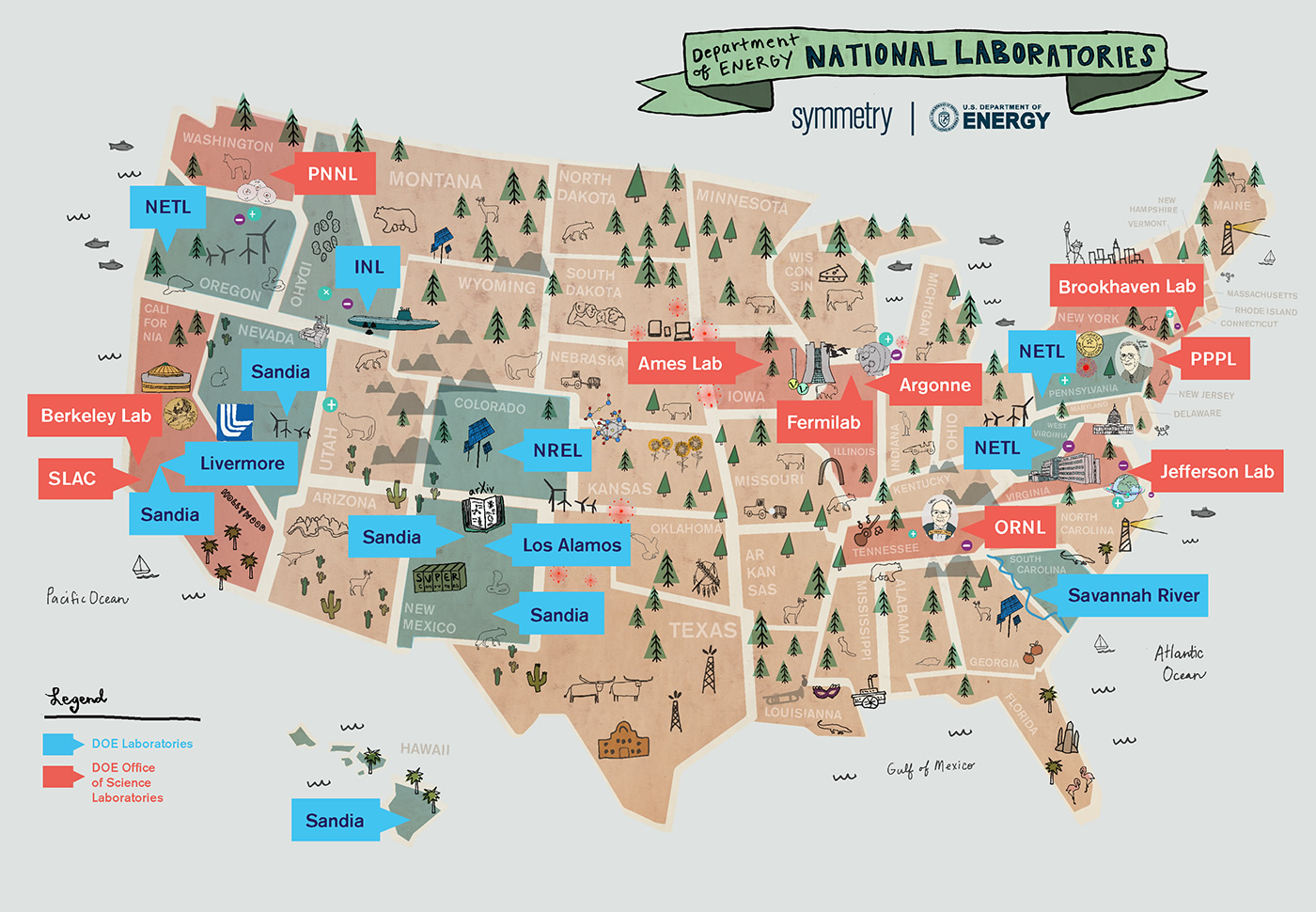
The Ames Laboratory

location
Ames, Iowa
areas of research
materials sciences and engineering; chemical and biological sciences; applied math and computational sciences; environmental and protection sciences; and simulation, modeling and decision science
did you know?
Ames researchers developed lead-free solder, an alloy of tin-silver-copper that is environmentally benign and has been widely adopted by the electronics industry as a universal bonding agent in all types of electronic devices from smart phones to computers.
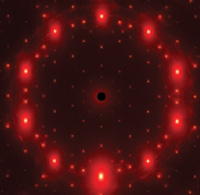
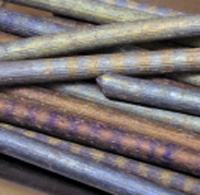
opened
1947
lab colors

blue, orange
employees
450 employees
animals on site
brown squirrels and chipmunks

Argonne National Laboratory

location
Lemont, Illinois
areas of research
physics, chemistry, biological sciences, energy storage, high-performance computing, national security, engines and alternative fuels, environmental science and nuclear energy
did you know?
Argonne scientists recorded the world’s first neutrino in a hydrogen bubble chamber on November 13, 1970.
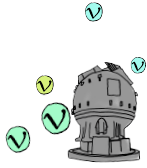
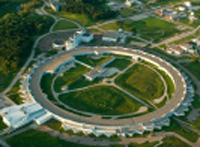
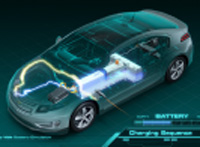
opened
1946
lab colors

green, red, blue
employees
3,500 employees
5,000 users/year
animals on site
white-tailed deer, coyotes, herons, egrets, beavers, snapping turtles and geese
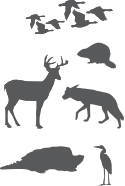
Brookhaven National Laboratory

location
Upton, New York
areas of research
nuclear and particle physics; photon sciences and nanomaterials; and crossdisciplinary research on climate change, sustainable energy and Earth’s ecosystems
did you know?
Brookhaven’s Relativistic Heavy Ion Collider holds a Guinness World Record for producing the highest man-made temperature—4 trillion degrees Celsius—while recreating conditions of the early universe in near light-speed particle smashups.

animals on site
eastern hog-nosed snakes—they play dead—endangered tiger salamanders, deer, turkeys, foxes and groundhogs

opened
1947
lab colors

black, red, white
employees
3,000 employees
4,000 users/year
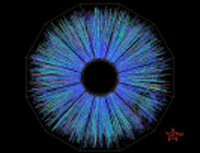
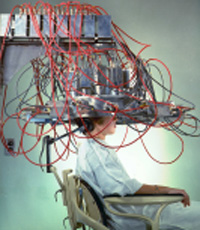
Fermi National Accelerator Laboratory

location
Batavia, Illinois
areas of research
particle physics and accelerator science and technology
did you know?
Fermilab built the first proton accelerator dedicated to the treatment of cancer patients in a hospital, the Loma Linda Medical Center in California.

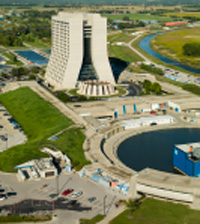
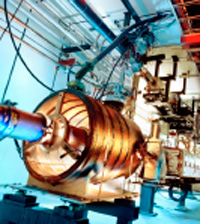
opened
1967
lab colors

blue, orange
employees
1,700 employees
4,600 users/year
animals on site
American bison, coyotes, geese and 285 other bird species
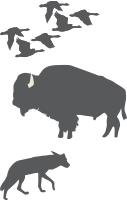
Idaho National Laboratory

location
Southeast Idaho
areas of research
nuclear science and engineering; national security research and testing; energy and environmental sustainability
did you know?
The technology for the world’s first nuclear-powered submarine was pioneered in the desert of Idaho. From 1953 to 1994, thousands of sailors trained there using full-scale submarine prototype reactors.

animals on site
sage grouse, pygmy rabbits, pronghorn, mule deer, elk, coyotes, bobcats, rattlesnakes, bears, moose, mountain lions and wolves

opened
1949
lab colors

blue, tan, orange
employees
3,500 employees
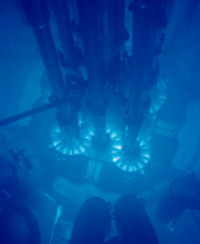
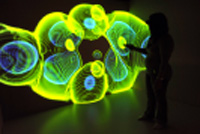
Lawrence Berkeley National Laboratory

location
Berkeley, California
areas of research
physics, chemistry, nuclear science, accelerator research, photon science and engineering sciences; computational research and mathematics; earth sciences; energy efficiency; materials sciences; and life sciences, genomics and physical biosciences
did you know?
Berkeley Lab claims 13 Nobel prizes: 10 for work done here, 2 for work by lab scientists who did the work elsewhere, and 1 for a large contingent of lab scientists who were members of the Intergovernmental Panel on Climate Change that shared the 2007 Peace Prize.

animals on site
mountain lions, foxes and turkeys

opened
1931
lab colors

blue, white
employees
4,000 employees
8,500 users/year
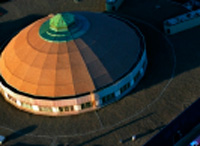
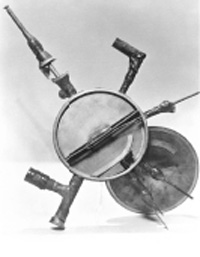
Lawrence Livermore National Laboratory

location
Livermore, California
areas of research
nuclear weapons stockpile stewardship, nuclear nonproliferation, high performance computing, national security, biology, energy research, climate science, additive manufacturing, lasers and high-energy-density physics
did you know?
Star Trek Into Darkness was filmed at the lab’s National Ignition Facility.

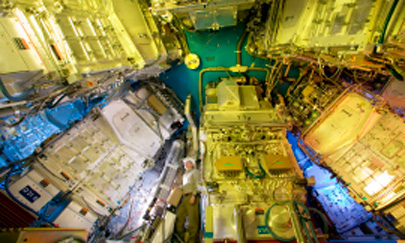
opened
1952
lab colors

blue
employees
6,500 employees
animals on site
red-legged frogs (a protected species), coyotes, wild turkeys and the occasional mountain lion
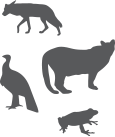
Los Alamos National Laboratory

location
Los Alamos, New Mexico
areas of research
accelerators and electrodynamics; bioscience, biosecurity and health; chemical science; Earth and space sciences; energy; engineering; high-energy-density plasmas and fluids; information science, computing and applied math; materials science; national security and weapons science; nuclear and particle physics; astrophysics and cosmology; and sensors and instrumentation systems
did you know?
A Los Alamos theorist created the arXiv, a free archive of scientific journal article preprints that revolutionized communications within the scientific community, in 1991. Today, arXiv contains close to 800,000 full texts, receives 83,000 new texts each year, and serves about 400,000 distinct users every week.
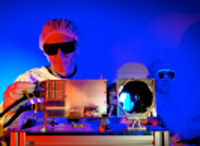
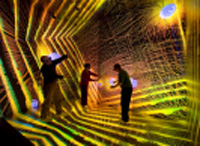
opened
1943
lab colors

blue, gold
employees
10,000 employees
1,200 users/year
animals on site
southwestern willow flycatchers, spotted owls, jemez mountain salamanders, black bears, elk, deer, bobcats, cougars and coyotes
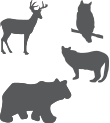
National Energy Technology Laboratory

location
Albany, Oregon; Pittsburgh, Pennsylvania; and Morgantown,West Virginia
areas of research
high-efficiency boilers, turbines, fuel cells and other power systems; emissions controls for coal-fired power plants; carbon capture and storage; efficiency and environmental quality of domestic oil and natural gas exploration, production and processing; and materials for extreme environments
did you know?
The United States has reduced its NOx emissions 88 percent and SO2 emissions 82 percent since 1970, essentially eliminating acid rain. Major contributors to these reductions have been the scrubbers, low-NOx burners and selective catalytic reduction systems demonstrated through the clean coal programs managed by NETL.
animals on site
fairy diddles, red foxes, wild turkeys, white-tailed deer and the occasional raccoon
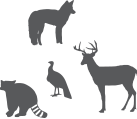
opened
1910
lab colors

blue
employees
1,500 employees
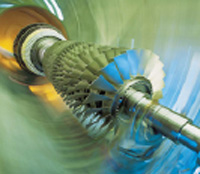
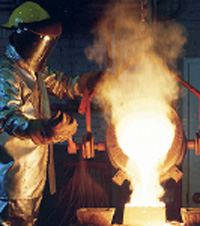
National Renewable Energy Laboratory

location
Golden, Colorado
areas of research
renewable energy and energy efficiency research and development, including energy systems integration, solar, wind, renewable fuels and vehicle systems, buildings, geothermal, energy sciences, computational sciences and energy analysis
did you know?
Laboratory-designed solar cells powered the first two Mars rovers, Spirit and Opportunity; the solar cells’ durability extended the rovers’ lifetimes beyond predictions.
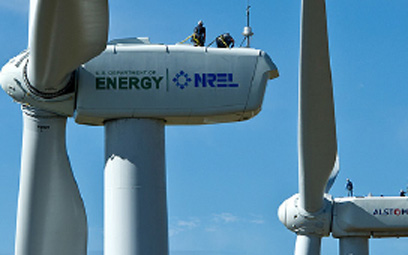
opened
1977
lab colors

blue
employees
2,500 employees
animals on site
mule deer, coyotes, foxes, raccoons, rabbits, mountain lions, American kestrels and red-tailed hawks
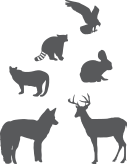
Oak Ridge National Laboratory

location
Oak Ridge, Tennessee
areas of research
energy-related science and technology, from basic research to the development and demonstration of breakthrough materials, processes and systems
did you know?
The 1994 Nobel Prize in physics was awarded to Clifford Shull for neutron diffraction techniques developed at ORNL’s Graphite Reactor, the world’s first continuously operating nuclear reactor. Today at ORNL and other labs around the world, neutron diffraction is used to reveal the underlying structure of materials and to create new materials for use in energy technologies, electronics and many other areas.
animals on site
black bears, groundhogs, deer, raccoons, water snakes, turkeys, snapping turtles, ospreys, bobcats and coyotes

opened
1943
lab colors

green
employees
4,400 employees
3,000 users/year
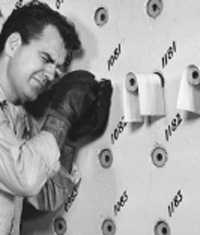
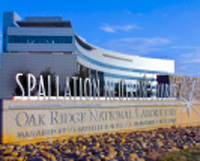
Pacific Northwest National Laboratory
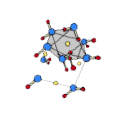
location
Richland, Washington
areas of research
chemical and molecular sciences; biological systems science; climate change science; subsurface science; chemical engineering; applied materials science and engineering; and applied nuclear science and technology
did you know?
In the early 1970s, PNNL invented a technique called optical digital recording that stores information as a track of dots about 1 micron in diameter. This innovation served as the critical design element for compact discs and players, later manufactured and sold worldwide.

animals on site
cottontail rabbits, red foxes, jackrabbits, coyotes and several species of waterfowl and birds of prey

opened
1965
lab colors

copper, silver
employees
4,500 employees
800 users/year
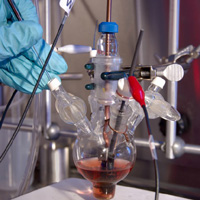
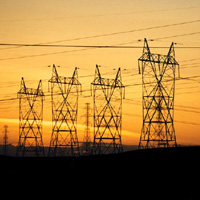
Princeton Plasma Physics Laboratory

location
Plainsboro, New Jersey
areas of research
nuclear fusion and plasma physics
did you know?
Laboratory founder Lyman Spitzer conceived of the laboratory during a Colorado ski trip after being inspired by thoughts of fusion as a boundless source of energy for generating electricity. The laboratory was founded as a classified facility under the code name “Project Matterhorn” in 1951; it was declassified in 1958 when it halted bomb research and became the Princeton Plasma Physics Laboratory in 1961.
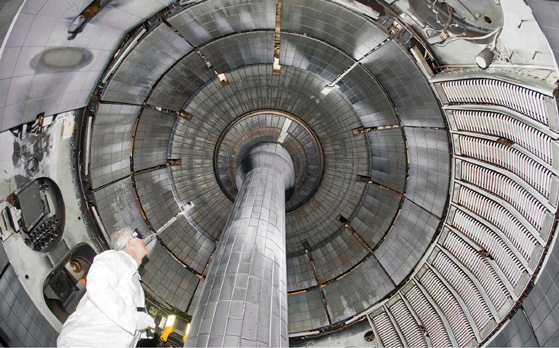
opened
1951
lab colors

orange, black
employees
450 employees
300 users/year
animals on site
wild turkeys

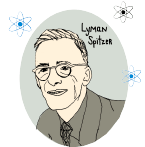
Sandia National Laboratories

locations
Albuquerque, New Mexico; Livermore, California; Tonopah, Nevada; Carlsbad, New Mexico; Kauai, Hawaii
areas of research
nuclear weapons; defense; energy; materials science and homeland security; nonproliferation; supercomputing and cybersecurity; robotics; climate and infrastructure security; nuclear reactor safety; nanodevices and microsystems; geosciences; bioscience; radiation effects; and nuclear fusion
did you know?
The “clean room” technology essential to every microelectronics fabrication plant and hospital surgery facility today was invented and patented for free use by Sandia engineers in 1961.
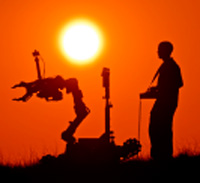
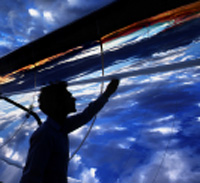
opened
1945
lab colors

blue
employees
10,000 employees
animals on site
greater roadrunners

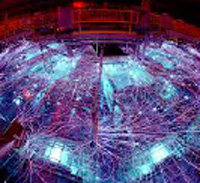
Savannah River National Laboratory

location
near Aiken, South Carolina
areas of research
environmental remediation and risk reduction; nuclear materials processing and disposition; nuclear detection, characterization and assessments; gas processing, storage and transfer systems
did you know?
To support U.S. nonproliferation efforts, SRNL has been involved in repatriation efforts for proliferant nuclear materials from around the world; in 2012, SRNL earned White House recognition for a three-year project to remove plutonium from Sweden for secure disposition in the United States.
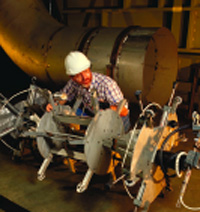
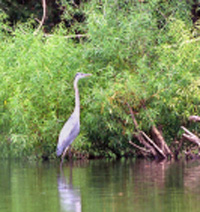
opened
1951
lab colors

blue, white
employees
825 employees
animals on site
alligators, white-tailed deer, wild turkeys and wild hogs

SLAC National Accelerator Laboratory

location
Menlo Park, California
areas of research
accelerator research; astrophysics and cosmology; biology; elementary particle physics; environmental science; materials, chemistry and energy sciences; scientific computing; and X-ray science
did you know?
At 3,073.72 meters (1.9 miles), the housing for SLAC’s linear accelerator is one of the longest buildings on Earth.
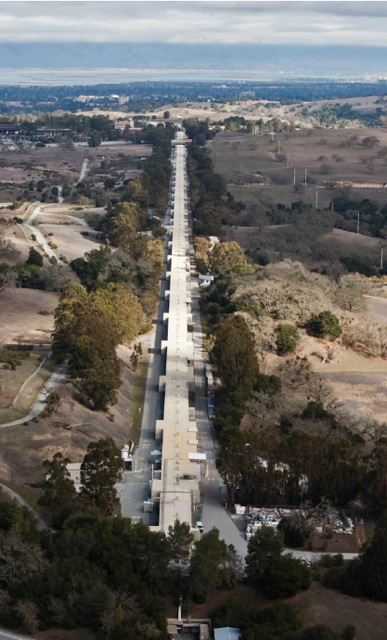
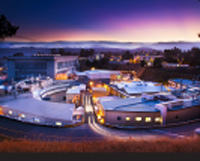
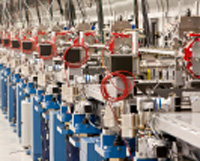
opened
1962
lab colors

red
employees
2,000 employees
3,400 users/year
animals on site
black-tailed deer, great horned owls and gopher snakes

Thomas Jefferson National Accelerator Facility

location
Newport News, Virginia
areas of research
experimental nuclear physics, computational and theoretical nuclear physics, accelerator science, cryogenics, superconducting radiofrequency technologies, radiation detectors, medical imaging devices and free-electron lasers
did you know?
An electron beam travels around Jefferson Lab’s accelerator five times in about 22 millionths of a second. At that speed, the electron beam could circle the Earth 7.5 times in one second.
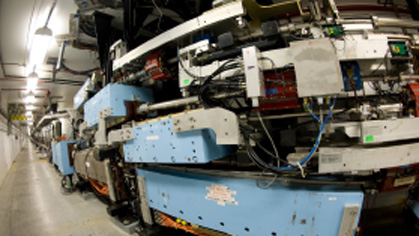
opened
1987
lab colors

red, black
employees
800 employees
1,350 users/year
animals on site
deer

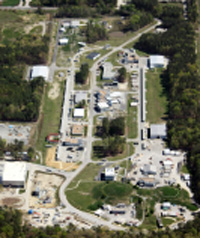
Lab Name
location
City, State
areas of research
Lorem ipsum dolor ist amet consecutor.
did you know?
Lorem ipsum dolor ist amet consecutor.